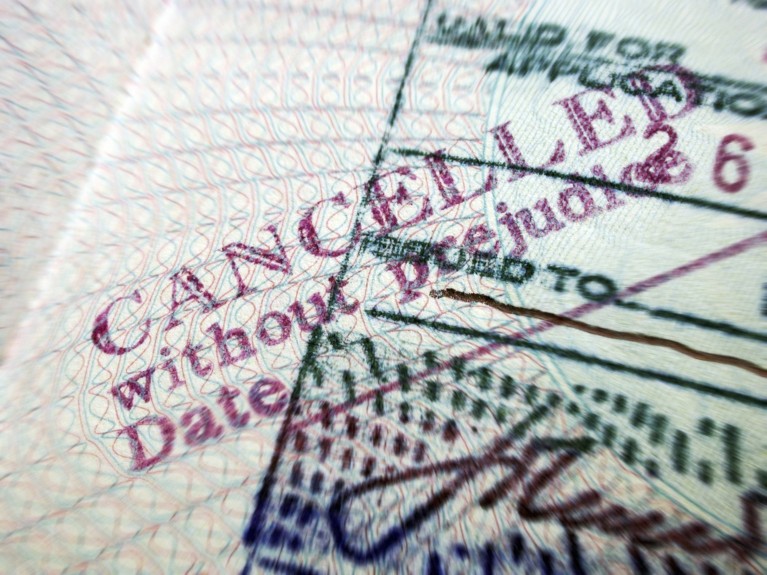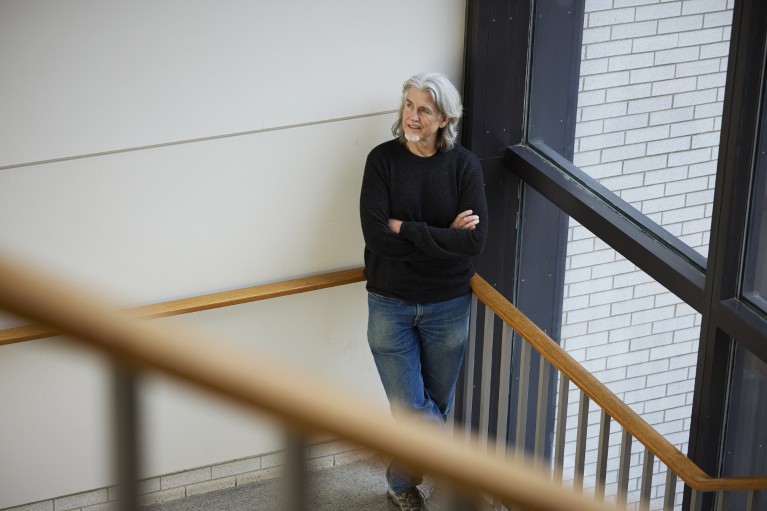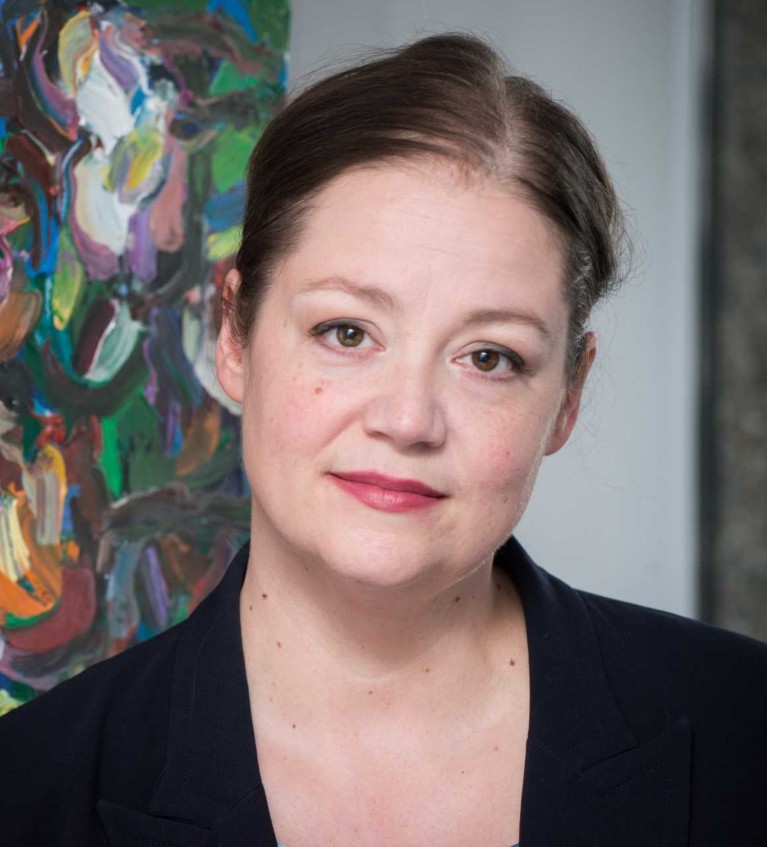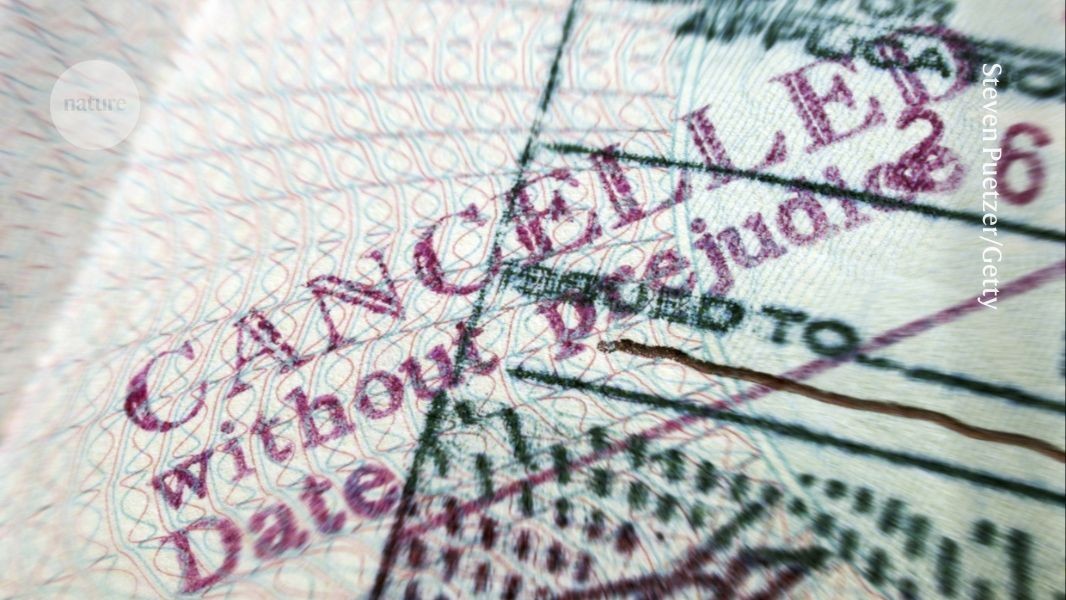
Credit: Steven Puetzer/Getty
Fatemeh Ajallooeian, was thrilled when, in June 2024, she received a Swiss National Science Foundation mobility fellowship to go abroad to continue her palaeoclimate research. Ajallooeian, then a biogeochemist at the Swiss Federal Institute of Technology (ETH) in Zurich, wrote a proposal with a colleague at Harvard University in Cambridge, Massachusetts, because, she told Nature, Harvard was the only institution with the state-of-the-art mass spectrometry equipment she needed to trace the microbial lipids that can act as indicators of past temperatures.
On 22 August that year, Ajallooeian, a postdoctoral researcher, applied to the US State Department for a category J visa, which is meant for exchange scholars with funds to cover their research and salary. Following Donald Trump’s re-election as US president in November 2024, she has been on an emotional rollercoaster. First there was the arrest of scholars who protested about the war in Gaza. Then, the attacks on Harvard began. But the truly heart-sinking moment occurred when Iran, her country of birth, appeared on the Trump administration’s updated travel ban list in June.
Over the past few months, Ajallooeian and her partner have e-mailed the US embassy in Bern 18 times, seeking updates on her visa application.
“I have had a lot of panic attacks,” she says. “I don’t have family in Iran. My research is not political.”
An Iranian citizen trying to get a visa to do palaeoclimate research at Harvard University is probably one of the most politically fraught combinations at this moment. On 28 July, Harvard terminated Ajallooeian’s application, citing the new travel ban. Her struggle is a microcosm of the uncertainties and mobility challenges that international scholars currently face amid anti-immigration sentiment in many countries.
Economic consequences
The visa bans and delays promise not only to upend the careers of international students but also to cause drastic economic impacts to the United States. In addition to the 4 June visa bans targeting 19 countries, visa interviews were paused between 27 May and 18 June 2025 — normally the peak period for issuing visas — for students seeking to enrol in a US institution this autumn.
China, India and Japan were among the countries reporting limited US appointments for their students during that period. If the issuing of visas does not recover significantly in July and August, up to 150,000 fewer international students will arrive in the United States this autumn, according to NAFSA: Association of International Educators, a non-profit organization, based in Washington DC, that is dedicated to international education and exchange. If those numbers materialize, the potential economic impact could reach US$7 billion in lost spending and lead to the loss of more than 60,000 jobs.
Immigration was already a hot topic in not just the United States, but also Canada, Australia and the United Kingdom. All four countries are heavily involved in training early-career researchers in science, technology, engineering and mathematics (STEM), and their policies have already, or could soon, set caps on visa numbers or raise visa fees.
At the same time, some countries are streamlining visa applications to attract coveted skilled workers. Last December, the Australian government introduced the national innovation visa: a permanent visa available to migrants, including global researchers, who have a demonstrated ability to benefit Australia’s prosperity. France, Germany and Ireland are increasing their international student recruitment. Later this year, the European Commission is expected to present a visa strategy for the European Union that will include measures to support the arrival of top students and researchers.
Nature’s careers team spoke to students, academics and immigration-policy specialists in the United States, Canada, Japan, the United Kingdom and Australia to take the pulse of student-visa challenges. Several early-career researchers requested anonymity for fear of visa reprisals.
US crackdown
The burdens on international visa holders in the United States are already considerable. A survey, conducted last year, of more than 700 international postdocs at Harvard Medical School found that many spent more than a month in their home country to renew their visa, at a cost of more than $2,000 in some cases1. Individuals from Asian countries, however, were especially likely to report that visa renewals can take up to six months and cost up to $5,000. As a consequence, nearly 75% of respondents reported anxiety and burnout; 30% reported taking time off work as a result.
The Trump administration has rolled out a number of controversial initiatives in a bid to curtail visas for international researchers. In April, at least 1,680 students had their international status terminated in a database called the Student and Exchange Visitor Information System. Almost 300 international students filed dozens of lawsuits aimed at challenging their visa terminations.
That same month, the US State Department announced that it would scrutinize the social-media activity of visitors to the country. In May, US secretary of state Marco Rubio announced that the department would vigorously revoke visas issued to students from China.

Harvard computational biologist John Quackenbush likens the US visa uncertainty that many foreign students face to a self-inflicted wound for the country.Credit: Kent Dayton/Harvard T.H. Chan School of Public Health
But 4 June proved most consequential for Ajallooeian. On that day, the Trump administration not only restricted international students from attending Harvard University, but also issued a travel ban on the citizens of twelve countries, including Iran, Libya, Sudan and Yemen, and strict travel restrictions on another seven countries, including Venezuela, Cuba and Turkmenistan.
An ongoing lawsuit filed by Harvard University has temporarily halted the ban on the attendance of international students. John Quackenbush, a computational biologist at Harvard T.H. Chan School of Public Heallth in Boston, Massachusetts, says that Harvard’s biostatistics programme admitted eight PhD students this year, roughly half the typical number, owing to concerns over funding. But only four students accepted; two international and two domestic. And the university is concerned that the two international students might not be able to attend because of current visa policies.
Quackenbush also oversees a two-year master’s in computational biology and quantitative genetics, one of three biostatistics master’s programmes that have grown in recent years to admit roughly 80 students annually, many of them from abroad.
Flurry of concern
But with the uncertainty about how many students will arrive in the autumn, it’s challenging to determine which classes to offer. “It’s so short-sighted, it’s a self-inflicted wound,” Quackenbush says. “If we want to make America great again, shouldn’t we accept the best and brightest from overseas?”
By 11 June, following a trade deal with China, however, President Trump signalled that students from China were now welcome — a sign that politics is playing a more prominent part in student exchange.
Visa denials for international scholars had already reached a high in 2024 — a trend that is anticipated to increase, according to the Cato Institute, a think tank based in Washington DC. The end result, it predicts, will be fewer visa applications.
The moves have caused a flurry of concern among overseas scholars. A student in China, who has just accepted an offer to do a master’s in biomedical informatics at the University of Washington in Seattle, says she was asked before her visa interview to supply information about her social-media accounts.
“It wasn’t a smooth process,” she says. Even though she has been accepted into the two-year master’s programme and certified as such by the university, she was only granted a one-year F-1 academic visa. She plans to take up the offer, knowing that she probably won’t be able to travel outside of the United States during the course. “I just feel so insecure about my future,” she says.
Undue stress
A fifth-year PhD student from China, who studies cancer immunotherapies at the University of Pennsylvania in Philadelphia, had come to the United States as an undergraduate during the first Trump administration. She stayed to take advantage of what she describes as “top-notch US biomedical research training”. Even though the new travel restrictions don’t specifically target China, they add undue stress to her life.
“I haven’t visited home in four years,” she says — and she doesn’t plan to until she’s completed her PhD. “I can’t take the risk.” The university’s international office has advised students from countries on the travel-ban list, and China, not to leave the country unless absolutely necessary. Not only can she not visit her family, she cannot travel to international conferences to present her work, build her professional network or find job leads. As a result, she feels isolated.
To feel more empowered, she engages with the university’s student union on visa issues. She’s helped to draft recommendations for international student protections, including paid visa leave to deal with the paperwork and interviews involved, and the setting up of a hotline for international-student visa issues (the university administration has so far rejected their proposals). Because international students cannot vote in US elections, “the union offers what few civil rights that international students have”, she explains.
Bleak outlook
Before the second Trump administration, she thought she would apply for a job at a US-based pharmaceutical company. Now, she plans to conduct a global job search because the US outlook is bleak as a result of visa issues and drastic cuts to research funding. “How am I, as an international worker, going to compete with laid-off US citizens?” she asks. “I want to work somewhere where I feel seen, valued and appreciated.”
Trump’s efforts to use international research visas from particular countries as a bargaining chip during trade negotiations are expected to further erode scientific exchange between the United States and China — and to have wide-ranging impacts. “I can think of few other policy levers you could pull to bring global science to a halt,” says Brendan Cantwell, a higher-education researcher at Michigan State University in East Lansing. US–China research collaborations, which are particularly important in the physical and natural-science fields, have been more difficult since the COVID-19 pandemic, he adds.
Cantwell predicts that international scholars will experience mixed messages, with universities seeking to reassure students amid the Trump administration’s anti-immigrant rhetoric. At the end of the day, however, one factor is likely to be the biggest concern — money. “Visas will be tougher to get but universities will still try to recruit and support students. But if research funding falls off a cliff, they will not be able to fund students or research projects,” he says.
Shifting global landscape
In recent years, Canada, Australia and the United Kingdom have also been grappling with how to balance immigration concerns with the desire to attract top scientific talent.
“The concerns about the numbers of international students in general pre-date the second Trump administration,” says Cantwell. And, he adds, concerns about rising housing costs and demands on public services that accompany influxes of immigrants have been the focus of lengthy political discussions in all three countries. In Canada, for example, the vast majority of international students end up at universities in the three largest cities — Toronto, Vancouver and Montreal — which has contributed to a spike in unaffordable housing.
Canada and Australia have imposed caps on incoming international students. In January 2024, for example, the Canadian government announced that it wanted to achieve zero net growth in its international student population — amounting to a 35% reduction in study permits that would be approved. Both countries, as well as the United Kingdom, have seen declines in international student applications.
The policy shifts have had a direct impact in Canada, says Larissa Bezo, president and chief executive of the Canadian Bureau of International Education, a non-profit organization of international education professionals based in Ottawa. “It sent the message that we were closing the door to international students — which we really have not,” she says. “We have room for hundreds of thousands of students and world-class STEM institutions keen to host them,” she adds, noting that study permits at universities located outside the big cities are often easier to obtain.
The student response has been immediate. Canada has seen a 32% drop in international student applications and a 48% decline in new study permits issued since 2023 — much more than its original 35% reduction target, according to ICEF Monitor, a website tracking international education and student recruitment. In the first quarter of 2025, there was a significant decline in applications from India, says Bezo.
Canada has not closed the door to foreign students, says Larissa Bezo.Credit: Gregory Abraszko
Similarly, Australia’s effort to slow the flow of foreign students, its total population of which sits at roughly 825,000, seems to have worked. A now-revoked policy known as Ministerial Direction 107, which gave Australia’s top universities priority in the processing of student-visa applications and doubled visa fees, effectively capped the number of international students at 270,000 last year — an annual decline of nearly 40%.


